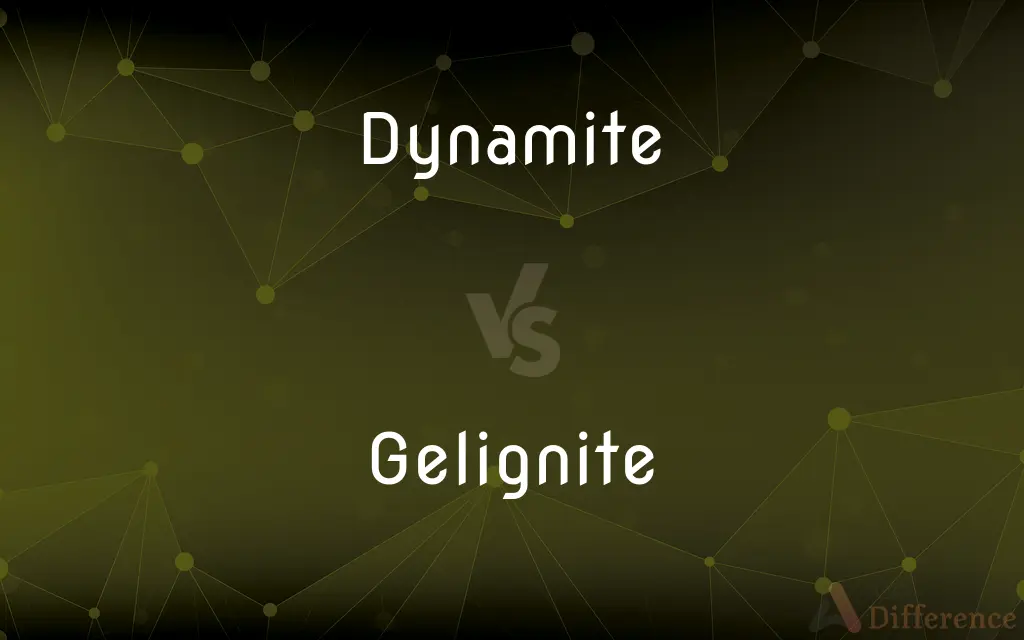Dynamite vs. Gelignite — What's the Difference?
By Tayyaba Rehman & Fiza Rafique — Updated on March 27, 2024
Dynamite consists of nitroglycerin absorbed into a stabilizing material, offering controlled explosions for mining; gelignite, or blasting gelatin, contains nitroglycerin and nitrocellulose, providing greater stability and water resistance.

Difference Between Dynamite and Gelignite
Table of Contents
ADVERTISEMENT
Key Differences
Dynamite was invented by Alfred Nobel in 1867 as a safer alternative to pure nitroglycerin, utilizing a stabilizing absorbent material like diatomaceous earth. This innovation made it safer to handle and use, especially in the mining industry. Gelignite, developed later by Nobel, includes both nitroglycerin and nitrocellulose, enhancing its stability and making it less sensitive to shock.
While dynamite comes in stick form, making it easy to use and transport, gelignite has a more gelatinous consistency, allowing it to be shaped and packed into boreholes of varying sizes and shapes. This flexibility makes gelignite particularly useful in wet conditions or underwater applications where traditional dynamite sticks might fail.
Dynamite's detonation requires a fuse and detonator to initiate the explosion, making it relatively safe to store and transport under proper conditions. Gelignite, although also needing a detonator, is considered safer due to its greater resistance to accidental detonation from shock or friction.
In terms of power, gelignite generally offers a stronger blast than dynamite due to its composition, making it preferred for more demanding demolition tasks. However, dynamite's ease of handling and relative safety continues to make it a popular choice for controlled explosions in mining and construction.
Despite their differences, both dynamite and gelignite share the common purpose of providing a manageable and efficient means of breaking rock and other hard materials. The choice between them often comes down to specific needs regarding stability, power, and environmental conditions.
ADVERTISEMENT
Comparison Chart
Composition
Nitroglycerin absorbed in stabilizing material.
Nitroglycerin and nitrocellulose.
Consistency
Sticks, solid form.
Gelatinous, more flexible.
Stability
Stable with careful handling.
Greater stability and shock resistance.
Water Resistance
Limited.
High, suitable for wet conditions.
Use
Mining, construction, demolition.
Demanding demolition, underwater use.
Invention
1867 by Alfred Nobel.
Later developed by Nobel for enhanced safety.
Detonation Method
Requires a fuse and detonator.
Requires a detonator, less sensitive to shock.
Safety
Relatively safe with proper handling.
Considered safer due to composition.
Preferred Use
Controlled explosions in safer conditions.
Tasks requiring high stability and power.
Compare with Definitions
Dynamite
Comes in stick form for easy application.
The demolition team strategically placed dynamite sticks for the controlled explosion.
Gelignite
A powerful explosive combining nitroglycerin and nitrocellulose.
Gelignite was used to demolish the old bridge foundations.
Dynamite
Ideal for mining and construction demolitions.
Dynamite is often chosen for its effectiveness in breaking rock.
Gelignite
Preferred for more demanding demolition tasks.
The construction company uses gelignite for its superior explosive power.
Dynamite
Requires careful handling and storage.
The dynamite was stored in a cool, dry magazine away from any ignition sources.
Gelignite
Suitable for underwater use.
Engineers used gelignite for controlled explosions during the harbor expansion project.
Dynamite
Designed for safety and controlled explosions.
Dynamite has revolutionized mining by providing a safer blasting method.
Gelignite
Offers flexibility and water resistance.
Due to its gelatinous nature, gelignite can be used in damp mining shafts.
Dynamite
An explosive made of nitroglycerin absorbed in a stabilizer.
The workers used dynamite to clear the large boulders blocking the construction site.
Gelignite
Known for its enhanced stability.
Gelignite's composition makes it less prone to accidental detonation.
Dynamite
Dynamite is an explosive made of nitroglycerin, sorbents (such as powdered shells or clay) and stabilizers. It was invented by the Swedish chemist and engineer Alfred Nobel in Geesthacht, Northern Germany and patented in 1867.
Gelignite
Gelignite (), also known as blasting gelatin or simply jelly, is an explosive material consisting of collodion-cotton (a type of nitrocellulose or guncotton) dissolved in either nitroglycerine or nitroglycol and mixed with wood pulp and saltpetre (sodium nitrate or potassium nitrate). It was invented in 1875, by Swedish chemist Alfred Nobel, who also invented dynamite.
Dynamite
A high explosive consisting of nitroglycerine mixed with an absorbent material and typically moulded into sticks.
Gelignite
A high explosive made from a gel of nitroglycerine and nitrocellulose in a base of wood pulp and sodium or potassium nitrate, used particularly for rock-blasting.
Dynamite
Blow up (something) with dynamite
He threatened to dynamite a major hydroelectric dam
Gelignite
An explosive mixture composed of nitroglycerine, guncotton, wood pulp, and potassium nitrate.
Dynamite
Any of a class of powerful explosives composed of nitroglycerin or ammonium nitrate dispersed in an absorbent medium with a combustible dope, such as wood pulp, and an antacid, such as calcium carbonate, used in blasting and mining.
Gelignite
An explosive mixture of nitroglycerine and nitrate absorbed onto a base of wood pulp.
Dynamite
Something exceptionally exciting or wonderful.
Gelignite
A type of dynamite in which the nitroglycerin is absorbed in a base of wood pulp and sodium or potassium nitrate
Dynamite
Something exceptionally dangerous
These allegations are political dynamite.
Dynamite
To blow up, shatter, or otherwise destroy with dynamite.
Dynamite
Outstanding; superb
A dynamite performance.
A dynamite outfit.
Dynamite
A class of explosives made from nitroglycerine in an absorbent medium such as kieselguhr, used in mining and blasting; invented by Alfred Nobel in 1867.
Dynamite
A stick of trinitrotoluene (TNT).
Dynamite
Anything exceptionally dangerous, exciting or wonderful.
Dynamite
To blow up with dynamite or other high explosive.
Dynamite
(metaphorically) To dismantle or destroy.
Dynamite
An explosive substance consisting of nitroglycerin absorbed by some inert, porous solid, as infusorial earth, sawdust, etc. It is safer than nitroglycerin, being less liable to explosion from moderate shocks, or from spontaneous decomposition.
Dynamite
An explosive containing nitrate sensitized with nitroglycerin absorbed on wood pulp
Dynamite
Blow up with dynamite;
The rock was dynamited
Common Curiosities
How does gelignite differ from dynamite?
Gelignite contains both nitroglycerin and nitrocellulose, making it more stable and water-resistant than dynamite.
What makes gelignite more stable than dynamite?
The addition of nitrocellulose to nitroglycerin in gelignite reduces its sensitivity to shock, enhancing its stability.
What is dynamite?
Dynamite is an explosive material made by absorbing nitroglycerin into a stabilizer, used for controlled explosions.
How is dynamite detonated?
Dynamite is detonated using a fuse and detonator to initiate the explosion safely.
What precautions are necessary when handling dynamite?
Proper storage, careful handling to avoid shock, and the use of a detonator are essential safety measures.
Can dynamite be used underwater?
While dynamite has limited water resistance, gelignite's gelatinous composition makes it better suited for underwater applications.
Is gelignite safer to handle than dynamite?
Yes, due to its enhanced stability and shock resistance, gelignite is considered safer to handle than dynamite.
What are the main uses of dynamite?
Dynamite is primarily used in mining, construction, and demolition for controlled explosions.
Why was dynamite invented?
Dynamite was invented by Alfred Nobel to provide a safer, more manageable alternative to pure nitroglycerin.
Why would someone choose gelignite over dynamite?
Gelignite is preferred for tasks requiring high stability, water resistance, and greater explosive power.
What is the best way to store gelignite?
Like dynamite, gelignite should be stored in a cool, dry place, away from any potential ignition sources.
What is the historical significance of dynamite?
Dynamite revolutionized construction and mining by providing a powerful yet controllable means of breaking rock.
How did the invention of gelignite improve upon dynamite?
Gelignite's formulation offers greater stability, safety, and flexibility, especially in wet conditions or underwater.
Can gelignite be molded into different shapes?
Yes, its gelatinous consistency allows it to be shaped to fit various blasting needs.
How are dynamite and gelignite similar?
Both are explosives designed for controlled demolition and contain nitroglycerin as a primary component.
Share Your Discovery

Previous Comparison
Firm vs. Industry
Next Comparison
Quorum vs. QuorateAuthor Spotlight
Written by
Tayyaba RehmanTayyaba Rehman is a distinguished writer, currently serving as a primary contributor to askdifference.com. As a researcher in semantics and etymology, Tayyaba's passion for the complexity of languages and their distinctions has found a perfect home on the platform. Tayyaba delves into the intricacies of language, distinguishing between commonly confused words and phrases, thereby providing clarity for readers worldwide.
Co-written by
Fiza RafiqueFiza Rafique is a skilled content writer at AskDifference.com, where she meticulously refines and enhances written pieces. Drawing from her vast editorial expertise, Fiza ensures clarity, accuracy, and precision in every article. Passionate about language, she continually seeks to elevate the quality of content for readers worldwide.














































